Kotlin Coroutines and OpenTelemetry Tracing
Explore the underlying workings of OpenTelemetry and analyze the workings of @WithSpan in general as well as within the context of Kotlin Coroutines.
Join the DZone community and get the full member experience.
Join For FreeI recently compared three OpenTelemetry approaches on the JVM: Java Agent v1, v2, and Micrometer. I used Kotlin and coroutines without overthinking. I received interesting feedback on the usage of @WithSpan with coroutines:
Indeed, the @WithSpan annotation has worked flawlessly in conjunction with coroutines for some time already. However, it made me think about the underlying workings of OpenTelemetry. Here are my findings.
The @WithSpan Annotation Processor
@WithSpan is a simple annotation. To be of any use, one needs an annotation processor. If you need a refresher on annotation processors, please check this not-so-new but still-relevant post.
A quick search on the OpenTelemetry repository reveals that the processor involved is WithSpanInstrumentation.
Here's an abridged summary of the classes involved:
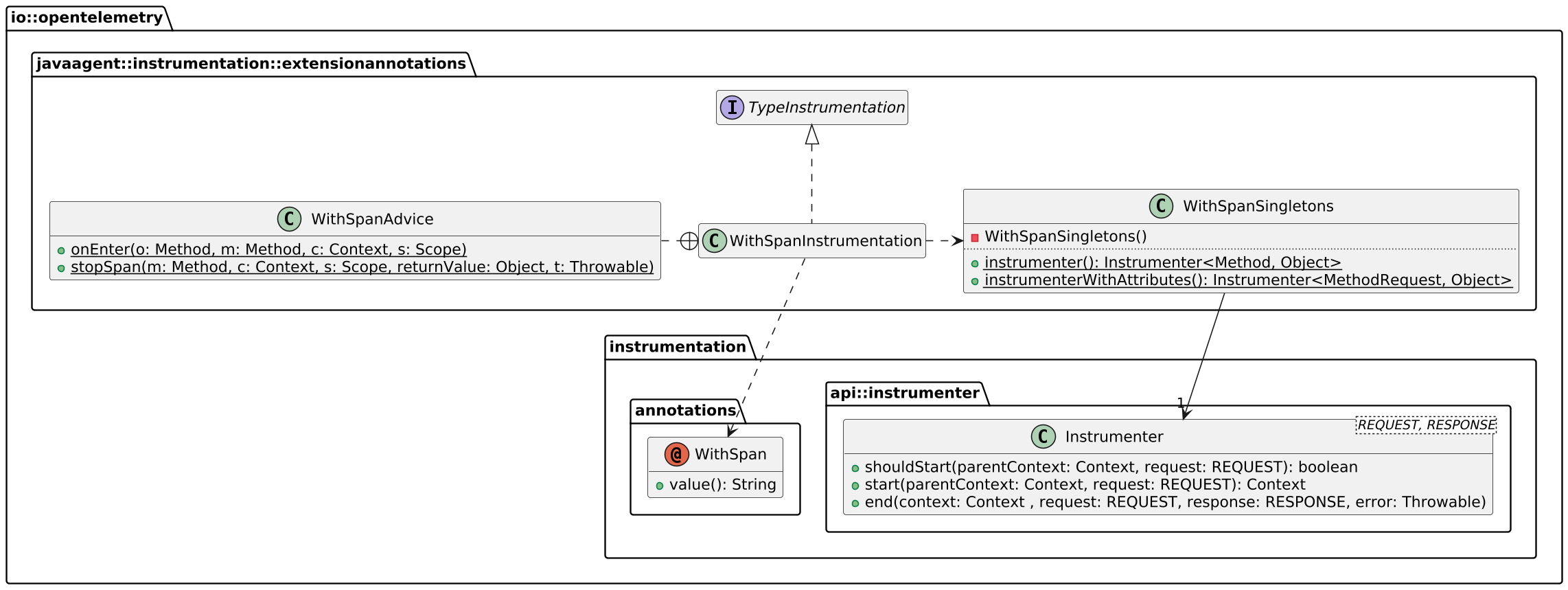
WithSpanInstrumentation does the annotation processing part; it delegates to WithSpanSingleton. In turn, the latter bridges the call to the Instrumenter class. Instrumenter contains the core of creating spans and interacting with the OpenTelemetry collector.
Instrumenter and Context
The
Instrumenterencapsulates the entire logic for gathering telemetry, from collecting the data, to starting and ending spans, to recording values using metrics instruments.An
Instrumenteris called at the start and the end of a request/response lifecycle.
When instrumenting a library, there will generally be four steps.
- Create an
InstrumenterusingInstrumenterBuilder. Use the builder to
configure any library-specific customizations, and also expose useful knobs to your user.- Call
Instrumenter#shouldStart(Context, Object)and do not proceed if it returnsfalse.- Call
Instrumenter#start(Context, Object)at the beginning of a request.- Call
Instrumenter#end(Context, Object, Object, Throwable)at the end of a request.For more detailed information about using the
Instrumentersee the Using the Instrumenter API page.
Instrumenter works in conjunction with Context. OpenTelemetry API users should be familiar with it, specifically the call to Context.current(). Let's describe it in more detail.
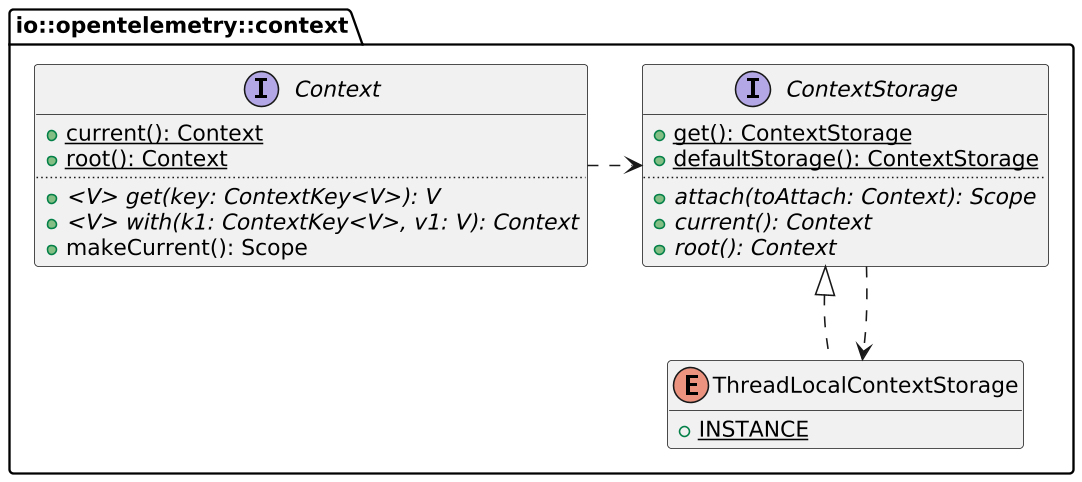
Context stores data in a ContextStorage instance, whose default is ThreadLocal. The ThreadLocal class has been the old-age way to pass data around without interfering with method signatures. It stores data in the current thread.
Kotlin's OpenTelemetry Extension
ThreadLocal works perfectly — until you spawn other threads. In this case, you must explicitly pass data around. So-called Reactive Programming frameworks, such as Spring WebFlux, do spawn other threads; most, if not all, provide utilities to handle the passing automatically.
Coroutines implement Reactive Programming. Not only do they spawn threads, but they also decouple coroutine from threads. A coroutine may "jump" across several threads in its lifetime. Thus, storing the OpenTelemetry context in a ThreadLocal doesn't work.
Yet, coroutines provide a dedicated storage mechanism, the coroutine context. We need a way to move the OpenTelemetry context from the ThreadLocal to the coroutine context and back again. The way exists in the opentelemetry-extension-kotlin jar:
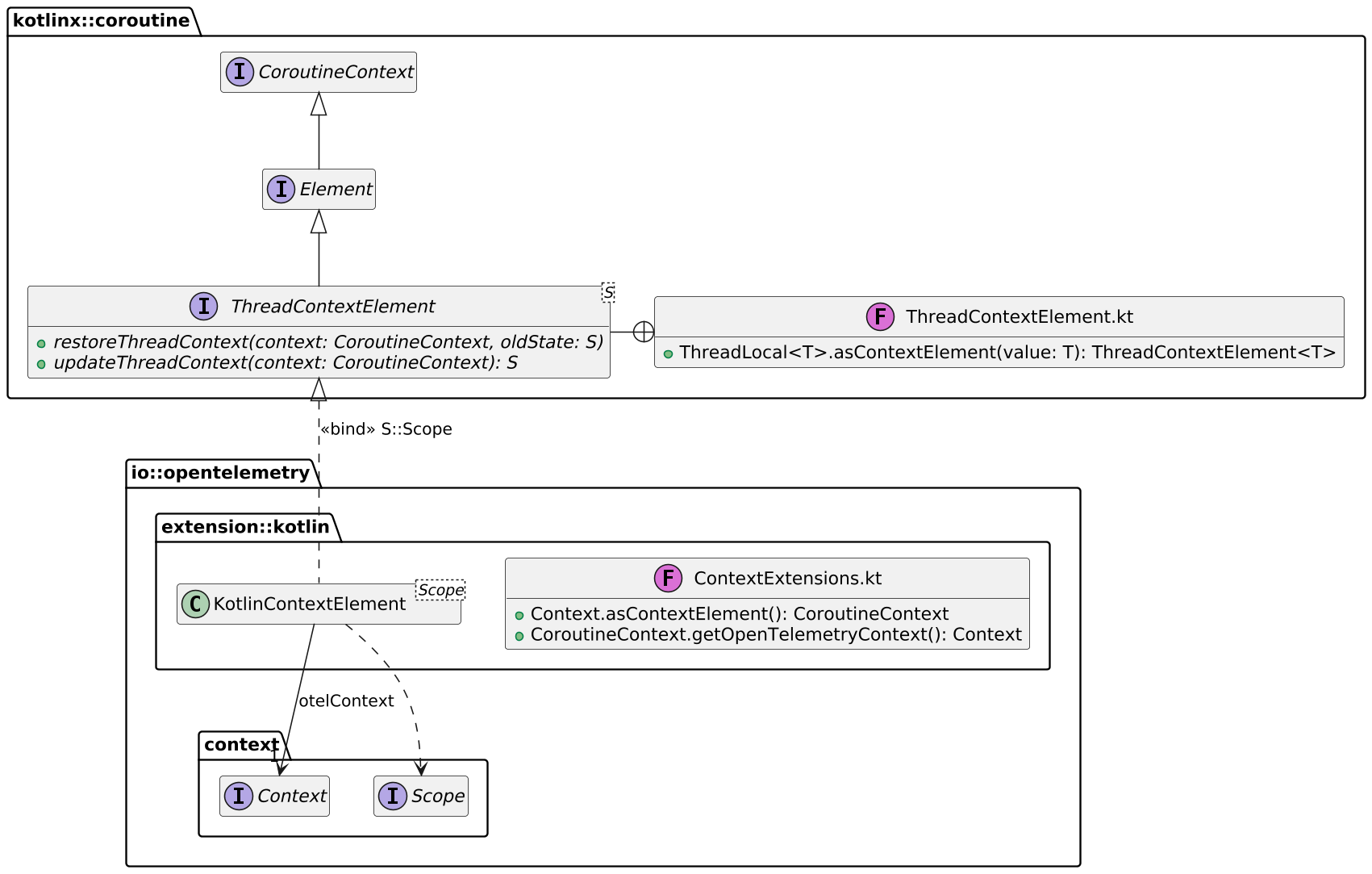
The only part that needs to be added is where these functions are called. Unsurprisingly, the magic happens in the Java Agent and all other instrumentation classes. You might remember the TypeInstrumentation interface on the first diagram, which the class WithSpanInstrumentation implemented. The Java Agent caters to many different frameworks and libraries, e.g., Spring WebFlux, and Kotlin Coroutines. Its developers designed it so each TypeInstrumentation concrete class focuses on the instrumentation of a specific aspect of the framework or library; coroutines are no exception.
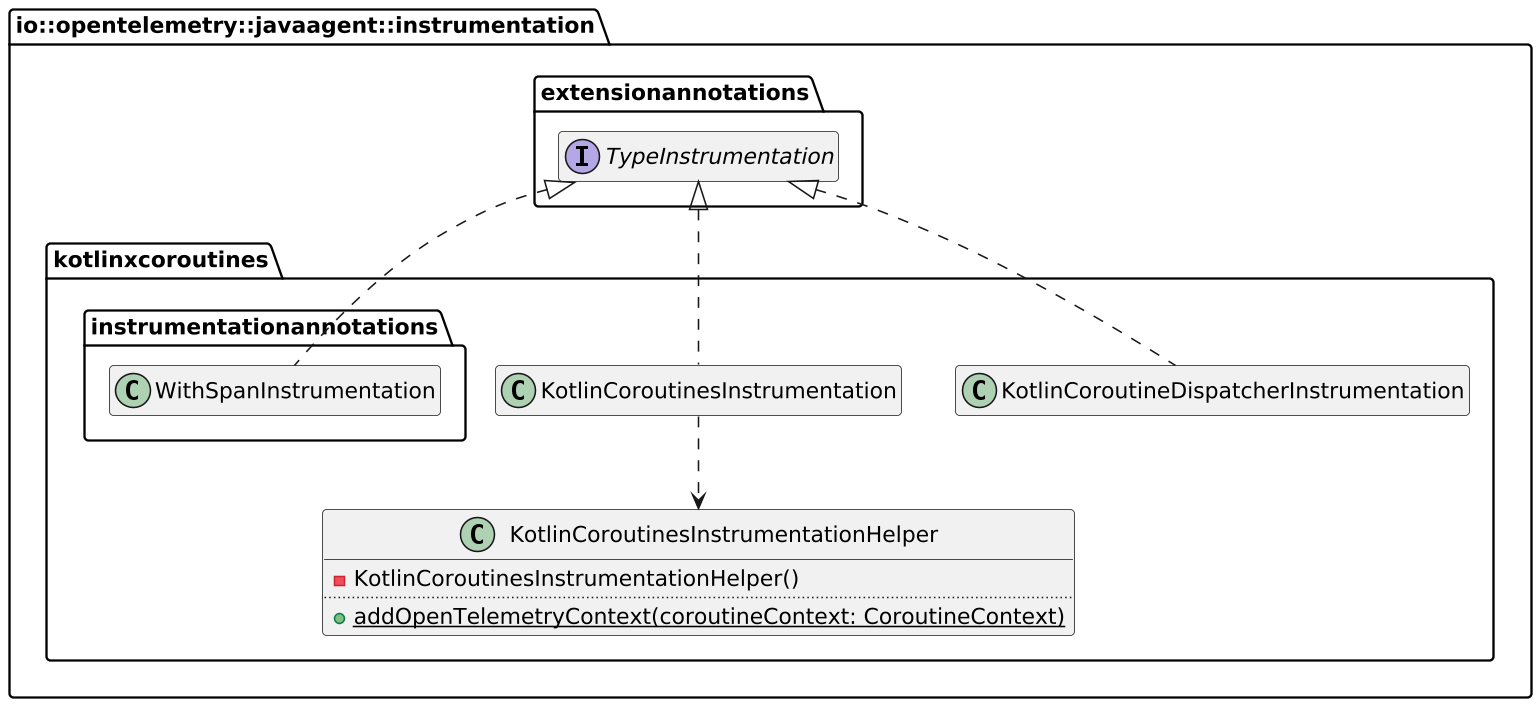
Note that the code provides a more specific instrumentation of WithSpanInstrumentation, which is dedicated to coroutines.
It turns out that the KotlinCoroutinesInstrumentationHelper contains the magic to copy the context from the ThreadLocal to the coroutine context:
package io.opentelemetry.javaagent.instrumentation.kotlinxcoroutines;
import io.opentelemetry.context.Context;
import io.opentelemetry.extension.kotlin.ContextExtensionsKt;
import kotlin.coroutines.CoroutineContext;
public final class KotlinCoroutinesInstrumentationHelper {
public static CoroutineContext addOpenTelemetryContext(CoroutineContext coroutineContext) {
Context current = Context.current(); //1
Context inCoroutine = ContextExtensionsKt.getOpenTelemetryContext(coroutineContext);
if (current == inCoroutine || inCoroutine != Context.root()) {
return coroutineContext;
}
return coroutineContext.plus(ContextExtensionsKt.asContextElement(current)); //2
}
private KotlinCoroutinesInstrumentationHelper() {}
}- Get the OpenTelemetry context - from the
ThreadLocal. - Add the context to the coroutine context.
And that's a wrap.
Summary
In this post, I've analyzed the workings of @WithSpan in general and in the context of Kotlin Coroutines. The Java Agent provides many different instrumenting classes, each dedicated to a unique facet of a framework or library. The WithSpanInstrumentation in the io.opentelemetry.javaagent.instrumentation.extensionannotations manages "regular" code; the one in io.opentelemetry.javaagent.instrumentation.kotlinxcoroutines manages coroutines.
The biggest challenge is that OpenTelemetry stores data in a ThreadLocal by default. The coroutine library doesn't guarantee the same thread will be used. On the contrary, a coroutine will likely bounce across different threads during its lifetime.
The Java Agent provides the mechanism to cope with it. One part focuses on moving OpenTelemetry data from the ThreadLocal to the coroutine context; the other provides a dedicated instrumentation to call the above code when it enters the latter.
To Go Further
Published at DZone with permission of Nicolas Fränkel, DZone MVB. See the original article here.
Opinions expressed by DZone contributors are their own.

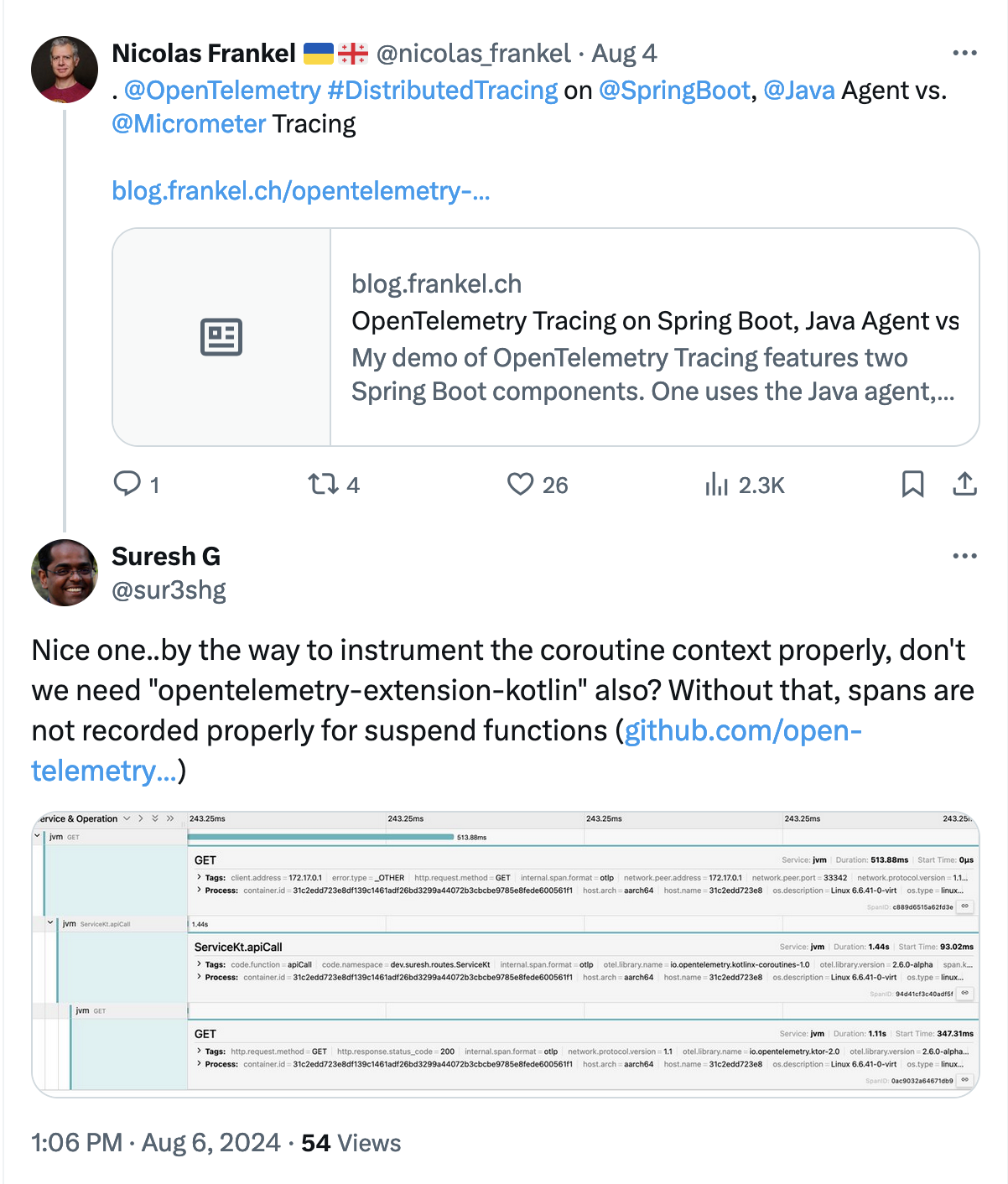
Comments